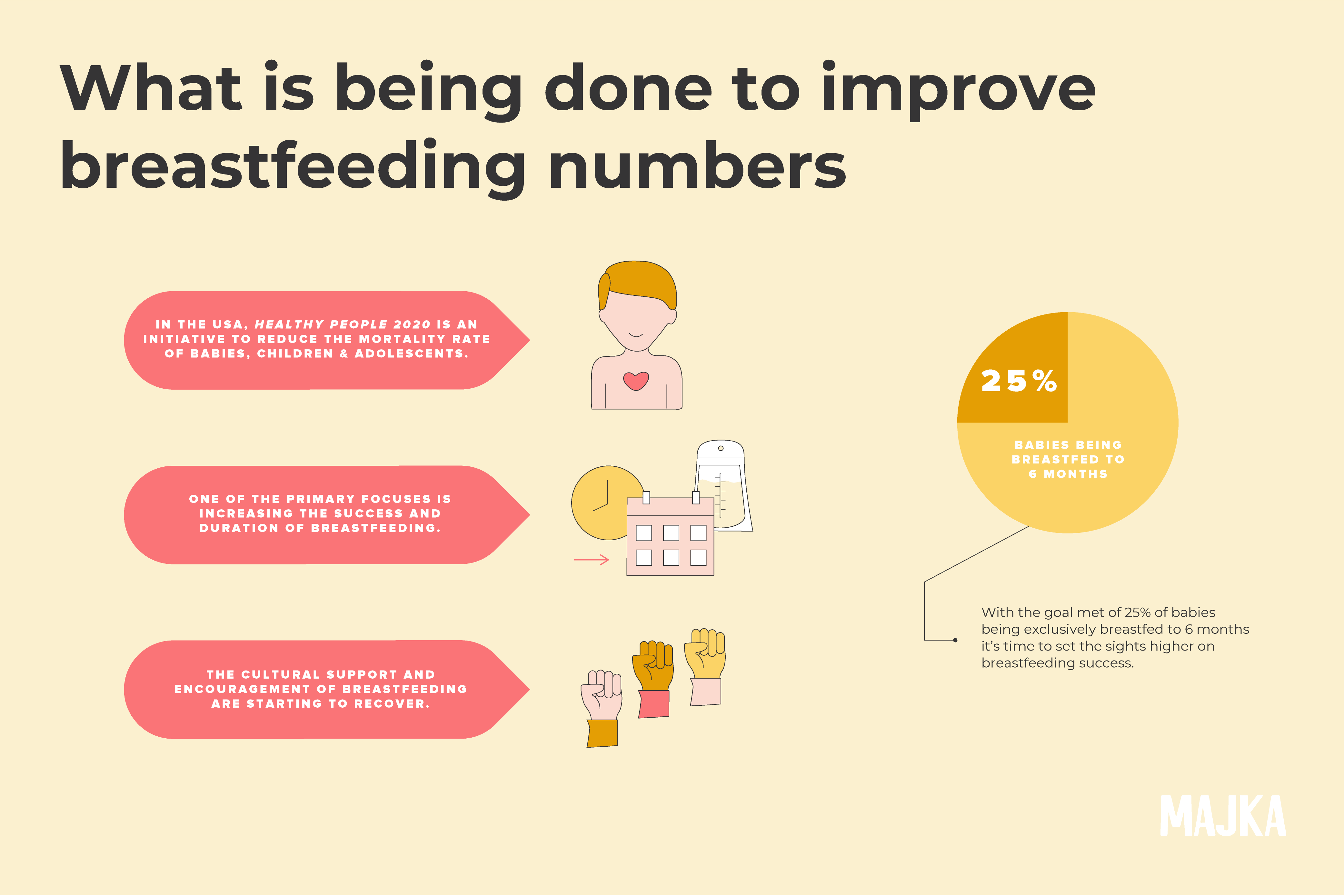Are you expecting a new baby? Though motherhood can sometimes seem like a lonely journey, over 10,300 babies are born each day in the USA. Breastfeeding is considered the best choice for a new baby, but it doesn’t come without its challenges or sometimes, a steep learning curve. Becoming a new mother, whether it be the 1st or 7th time, is always a new adventure as you learn who you are and how to best care for yourself and your little one.

Breastfeeding remains one of the most highly regarded recommendations to protect a baby’s and mother’s health, and yet both numbers in the USA and worldwide demonstrate there is a gap between the ideal recommendations and support for mothers to successfully breastfeed.
|
Imagine that the world had created a new "dream product" to feed and immunize everyone born on Earth. Imagine also that it was available everywhere, required no storage or delivery, and helped mothers plan their families and reduce the risk of cancer. Then imagine that the world refused to use it." —Frank Oski, M.D. |

What are the Recommendations for Breastfeeding?
The American Academy of Pediatrics (AAP) is one of the most thorough resources for breastfeeding. They stress that breastfeeding is not only a lifestyle choice but also one of the USA’s largest public health issues. (1)
- Exclusive breastfeeding or use of human milk for the first 6 months
- Complimentary breastfeeding (or use of human milk) while solid foods are introduced at and after 6 months
- Continuing breastfeeding until at least 1 year or beyond, as desired by the mother and baby
- Most growth curves for babies are not based on exclusive breastfeeding and may cause undue alarm. The growth curve by the World Health Organization (WHO) is the best reference for optimal growth for breastfed infants in any area of the world
- Medical contraindications for breastfeeding are rare
- Breastfeeding should be supported by pediatricians and hospitals as well as a woman’s workplace
Why is Breastfeeding Important?
Breastfeeding and the use of human milk are considered the best choice for the health of the baby and have many benefits to the mother as well. Mothers should always be supported to breastfeed in a way that best serves them and their families.
Breastmilk is uniquely tailored for each baby and is nutrient-rich with prebiotics, antibodies, enzymes, and the perfect amount of protein, fat, and carbohydrates for growth and development. Breastfeeding protects and improves the health of an infant in many ways.
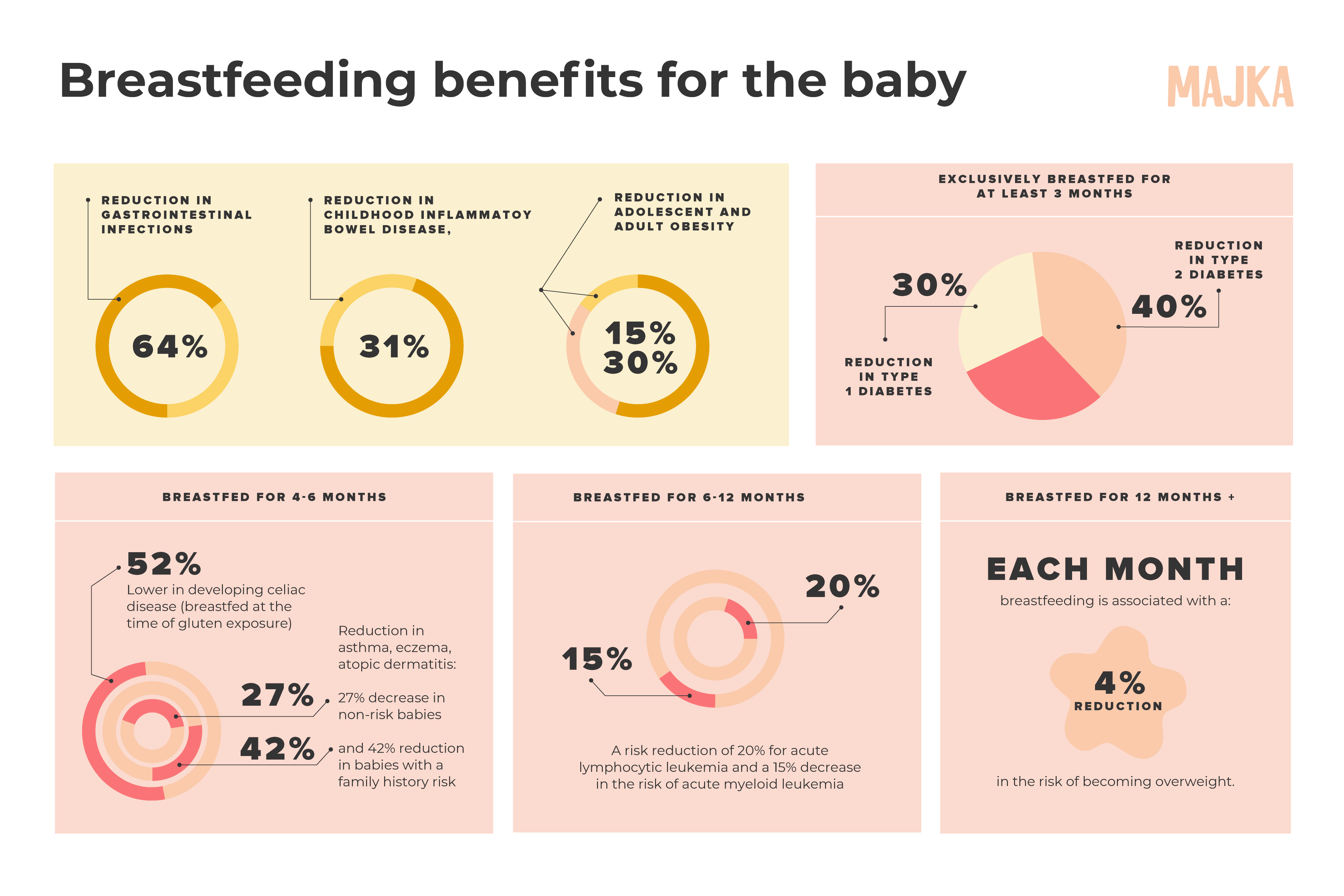
Breastfeeding Benefits for the Baby
Any breastfeeding
- Preterm infants are 58%-77% less likely to have necrotizing enterocolitis by being given human milk
- Otitis media (middle ear inflammation) with any breastfeeding was reduced 23%, exclusive for 3 months results in a 50% decrease
- Any breastfeeding gives a 64% reduction in gastrointestinal infections
- 36% reduction in SIDS
- 31% reduction in childhood inflammatory bowel disease, probably due to the gut flora of a breastfed baby being different than one that is formula-fed
- With any breastfeeding, there is a 15-30% reduction in adolescent and adult obesity
3 months
- 30% reduction in type 1 diabetes in infants exclusively breastfed for at least 3 months
- 40% reduction in type 2 diabetes in infants exclusively breastfed for at least 3 months
- A notable difference in intelligence if breastfed exclusively for 3 months and even better results with breastfeeding extended beyond 3 months
4-6 months
- Respiratory tract infections:
- The risk of hospitalization for lower respiratory tract infections in the first year is reduced by 72% if infants breastfed exclusively for more than 4 months.
- Reduction in asthma, eczema, atopic dermatitis with exclusive breastfeeding for 4-6 months, a 27% decrease in non-risk babies and a 42% reduction in babies with a family history of these conditions.
- Developing Celiac disease is 52% lower in infants breastfed at the time of gluten exposure and a longer duration of breastfeeding seems to have a continued positive effect
6-12 months
- Infants who exclusively breastfed for more than 6 months were 4 times less likely to get pneumonia compared with infants who exclusively breastfed for 4-6 months
- A risk reduction of 20% for acute lymphocytic leukemia and a 15% decrease in the risk of acute myeloid leukemia in infants breastfed for 6 months or longer.
12+ months
- Each month breastfeeding is associated with a 4% reduction in the risk of becoming overweight. Bottle feeding, even of expressed milk, may not provide quite the same benefit
- Continued immune system benefits
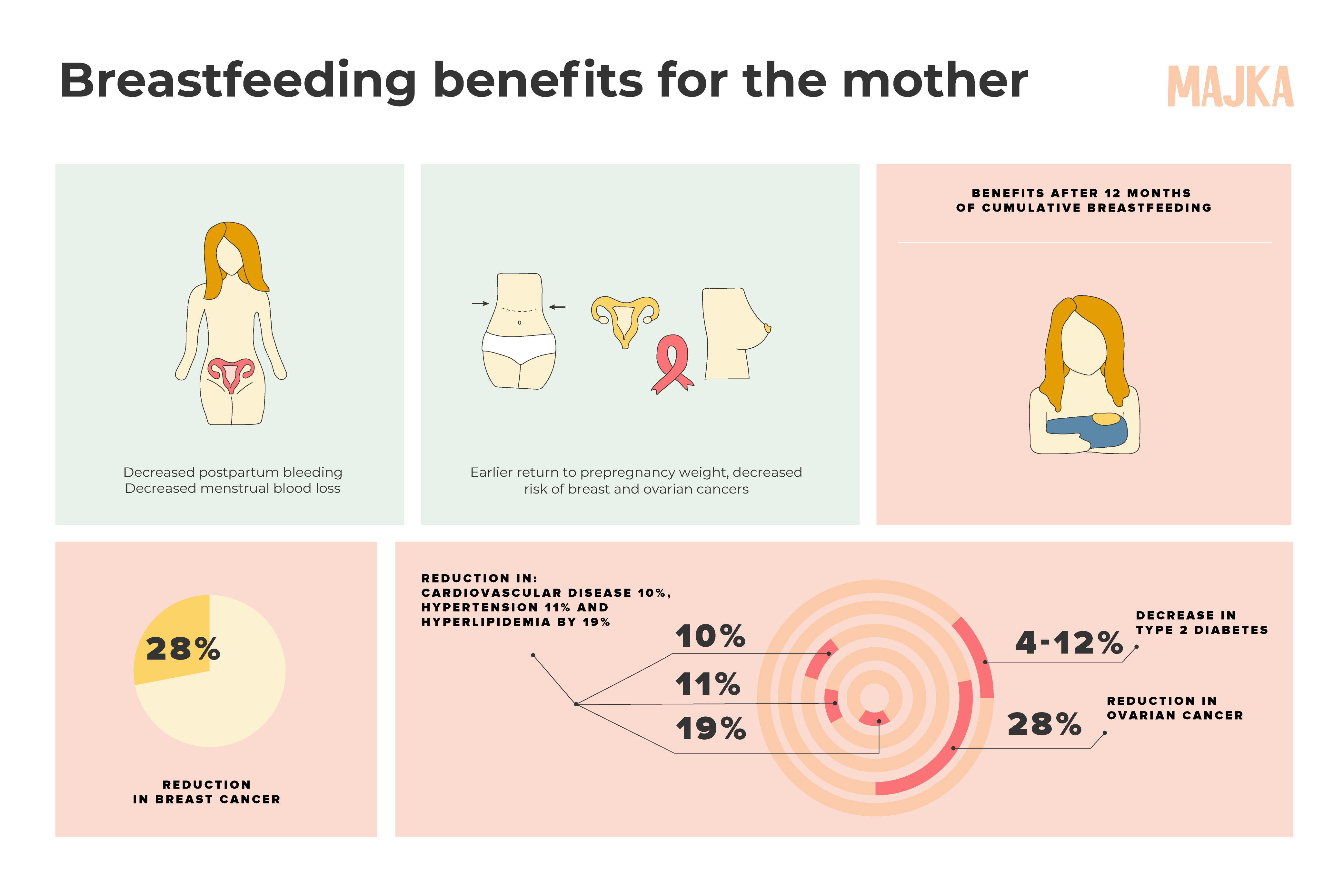
Breastfeeding Benefits for the Mother
- Decreased postpartum bleeding her uterus more quickly returning to pre-pregnancy size
- Decreased menstrual blood loss and increased child spacing (lactational amenorrhea)
- Earlier return to pre-pregnancy weight
- Decreased risk of breast and ovarian cancers
Benefits to the mother are striking after 12 months of cumulative breastfeeding.
These benefits include:
- 4-12% decrease in type 2 diabetes for each year the mother breastfed
- With a cumulative breastfeeding duration of 12 months to 24 months, the mothers risk of rheumatoid arthritis risk was 20% and 50% respectively
- Cumulative breastfeeding duration of longer than 12 months leaves a 28% reduction in breast cancer
- And 28% reduction in ovarian cancer for 12 months or longer
- Cardiovascular disease risk goes down 10%, hypertension does down 11% and hyperlipidemia by 19% with a cumulative 12-23 months of breastfeeding
Economic Benefits
Exclusive breastfeeding for 6 months would save 13 billion per year in the health care system (NOT accounting for parenting missing work or health care costs in adults due to diseases that came on in childhood)
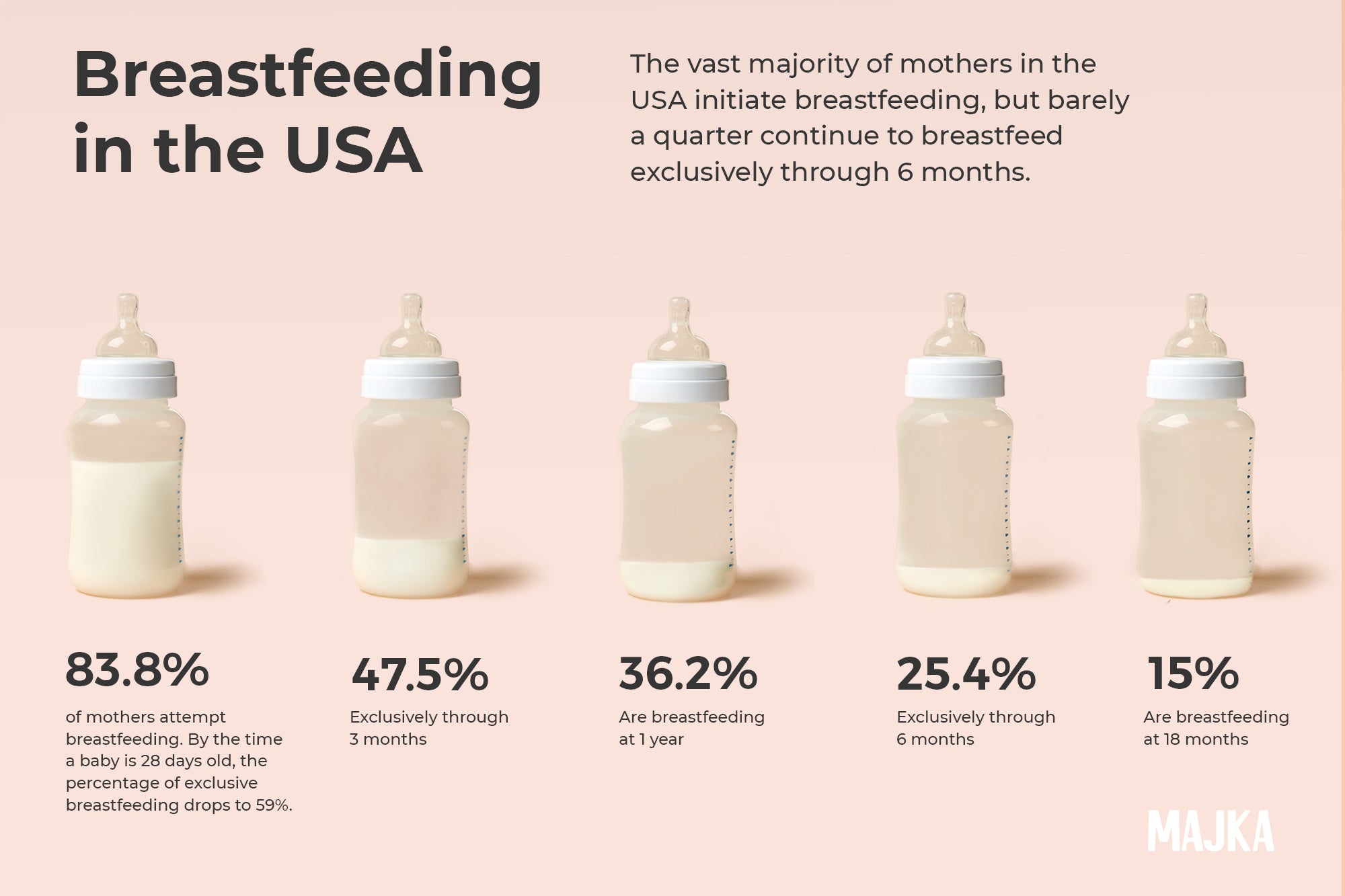
Breastfeeding in the USA
The vast majority of mothers in the USA initiate breastfeeding, but barely a quarter continues to breastfeed exclusively through 6 months. Many initiatives have been created to increase these numbers and the success rates of breastfeeding with little change in the numbers over the past 5 years. (2)
- 83.8% of mothers attempt breastfeeding
- By the time a baby is 28 days old, the percentage of exclusive breastfeeding drops to 59%
- 47.5% exclusively through 3 months
- 25.4% exclusively through 6 months
- 36.2% are breastfeeding at 1 year
- 15% are breastfeeding at 18 months
Supplementation
17% of babies are supplemented with formula the first 2 days of life, which is not only rarely medically necessary but the early introduction of formula is a factor in reducing the duration of breastfeeding. (2)
60% of mothers stop breastfeeding before they had planned to. While the duration of breastfeeding varies widely, one study found the average length was 17 weeks. (3) This is far from the 26 week (6 months) benchmark of exclusive breastfeeding. (2)
Approximately 35% of babies older than 6 months are fed both breastmilk and formula, which is often referred to as being combo fed. (2)
Approximately 30% of babies less than 3 months are combo fed in the USA
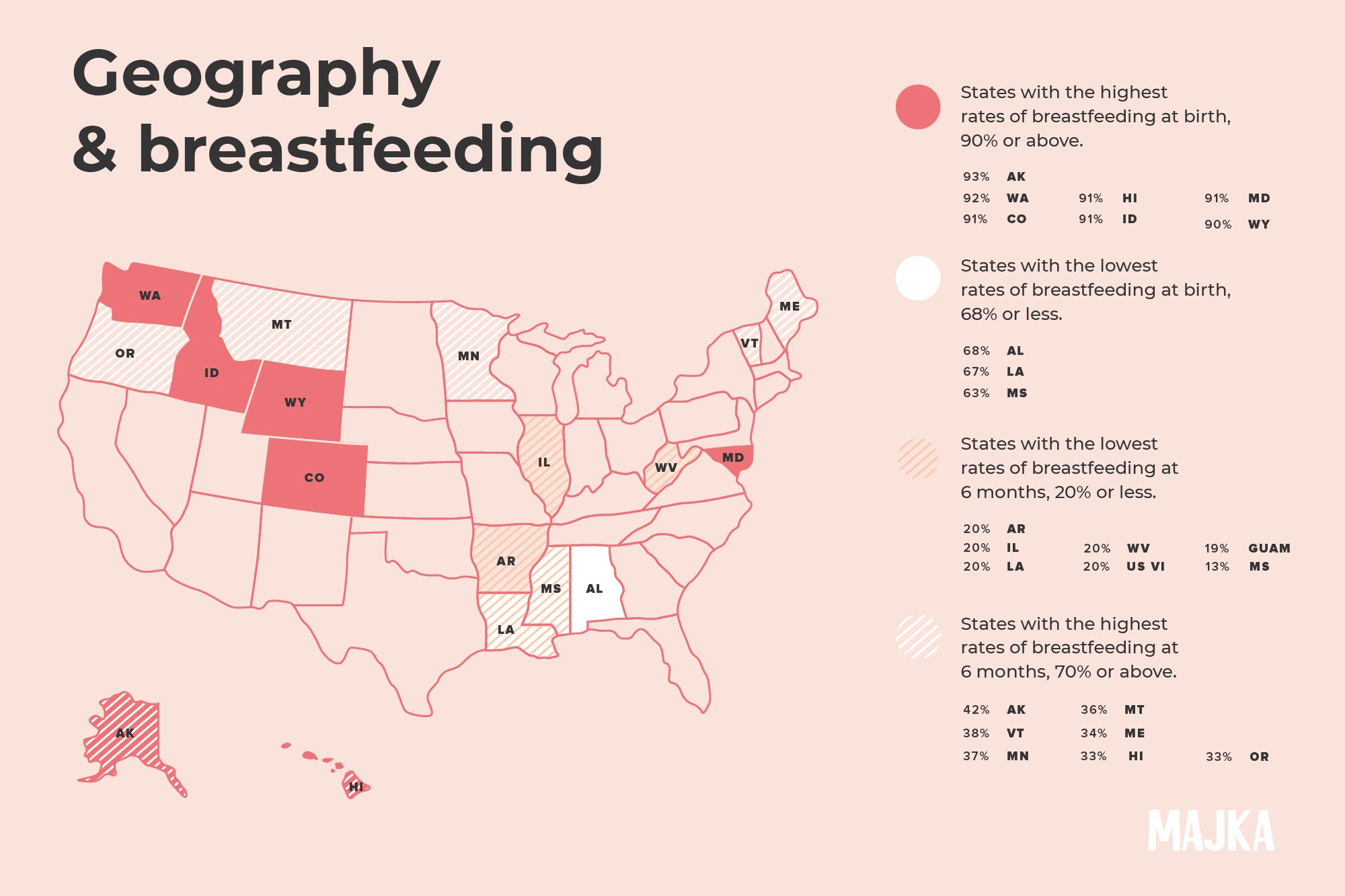
Geography and Breastfeeding in the USA
There are distinct patterns depending on the geography of where a baby a born. Something as broad as birthplace has a distinct influence on breastfeeding success. (2)
At Birth:
States with the lowest rates of breastfeeding, 68% or lower are:
- Alabama (68%)
- Louisiana (67%)
- Mississippi (63%)
States with the highest rates of breastfeeding, 90% or above are:
- Alaska (93%)
- Colorado (91%)
- Hawaii (91%)
- Idaho (91%)
- Maryland (91%)
- Washington (92%)
- Wyoming (90%)
Exclusive Breastfeeding at 6 Months:
States with the lowest rates of breastfeeding
- Arkansas (20%)
- Guam (19%)
- Illinois (20%)
- Louisiana (20%)
- Mississippi (13%)
- US Virgin Islands (20%)
- West Virginia (20%)
States with the highest breastfeeding rates, 70% or above are:
- Alaska (42%)
- Hawaii (33%)
- Maine (34%)
- Minnesota (37%)
- Montana (36%)
- Oregon (33%)
- Vermont (38%)
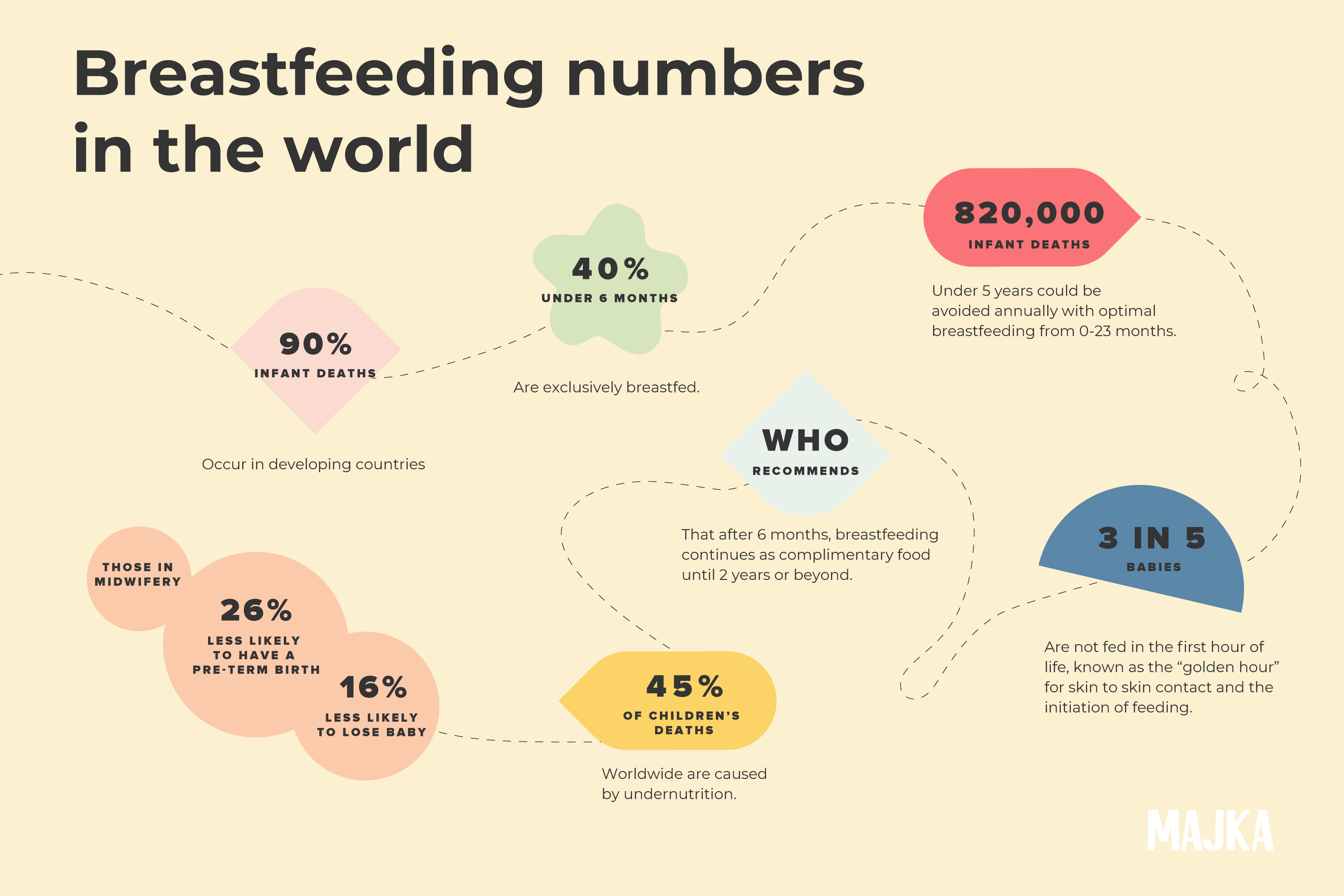
Breastfeeding Numbers in the World
90% of infant deaths occur in developing countries. The number one factor that would impact this is successfully exclusively breastfeeding for 6 months and continuing complimentary, on-demand breastfeeding. (4)
- 40% of babies under 6 months are exclusively breastfed.
- 820,000 deaths of children under 5 years could be avoided annually with optimal breastfeeding from 0-23 months.
- 3 in 5 babies are not fed in the first hour of life, known as the “golden hour” for skin to skin contact and the initiation of feeding.
- WHO recommends that after 6 months, breastfeeding continues as complimentary food until 2 years or beyond.
- Undernutrition is responsible for 45% of children’s deaths worldwide
- Those in midwifery are 16% less likely to lose their baby and 26% less likely to have a pre-term birth.

Top Challenges and Barriers for the Breastfeeding Mom
The largest indicators of successful breastfeeding are race and income in the USA. There are massive disparities in the care for mothers of color, particularly with black mothers. There are gaps in support in learning to breastfeed and poor community encouragement to do so. Professional and medical biases can do a lot of harm and there is much work to be done in this area.
900 infants’ lives would be saved each year if 90% of women exclusively breastfed for 6 months. (2)
75% of non-Hispanic black infants are ever breastfed vs. 87% of non-Hispanic white infants. The rate of any breastfeeding for and Hispanic infants is 82%. (2)
Those eligible and using a Special Supplemental Nutrition Program (WIC) are 75% likely to be breastfed at any time compared to those eligible but not participating in the program at 89%. Babies not eligible are breastfed at any point 93% of the time. (2)
Young mothers, aged 20-29 are 6% less likely to breastfeed than those 30 and above. (2)

5 practices that increase breastfeeding success that are not dependent on socioeconomic status are:
- Initiating breastfeeding in the first hour after the baby is born (which includes immediate skin to skin time, which is possible even in cesarean sections)
- Exclusive breastfeeding impacts the duration and success of breastfeeding overall
- Rooming-in with the mother 24 hours a day
- Avoidance of pacifiers
- Phone support after being discharged from the hospital
US Hospital Practices that are Harmful to Breastfeeding
- Suggesting limited time at the breast
- Providing pacifiers
- Supplementing with formula (most often at less than 2 days old)
- Giving formula samples in the discharge kit
Reasons Why Mothers Stop Breastfeeding
- Issues with lactation & latching
- Concerns about infant nutrition & weight (Growth curves that mothers have access to via phone apps and doctors’ appointments may not be an appropriate model for an exclusively breastfed baby. The WHO has the most accurate model regardless of ethnicity and location.)
- Concerns about the compatibility of the mother’s medications with breastfeeding
- Unsupportive work practices and limited parental leave
- Cultural norms, bias & lack of family support
- Unsupportive hospital practices and policies
What Is Being Done to Improve Breastfeeding Numbers
In the USA, Healthy People 2020 is an initiative to reduce the mortality rate of babies, children & adolescents. One of the primary focuses is increasing the success and duration of breastfeeding. Hospital practices and policies have been encouraged to change to a “baby-friendly facility” with a 10 step plan. Though numbers have a lot of room to grow, there have been improvements in breastfeeding education, a reduction in supplemental feeding, and essential practices such as early skin to skin time and initiation of breastfeeding being put in place. With the goal met of 25% of babies being exclusively breastfed to 6 months it’s time to set the sights higher on breastfeeding success.
Women are starting to take power back into their own hands more and more as information and resources become more readily available. The cultural support and encouragement of breastfeeding are starting to recover after the push for formula 1960s and 1970s. Birth practices and options are wider and more diverse and there are advocates working on the ground to support those that most need it.
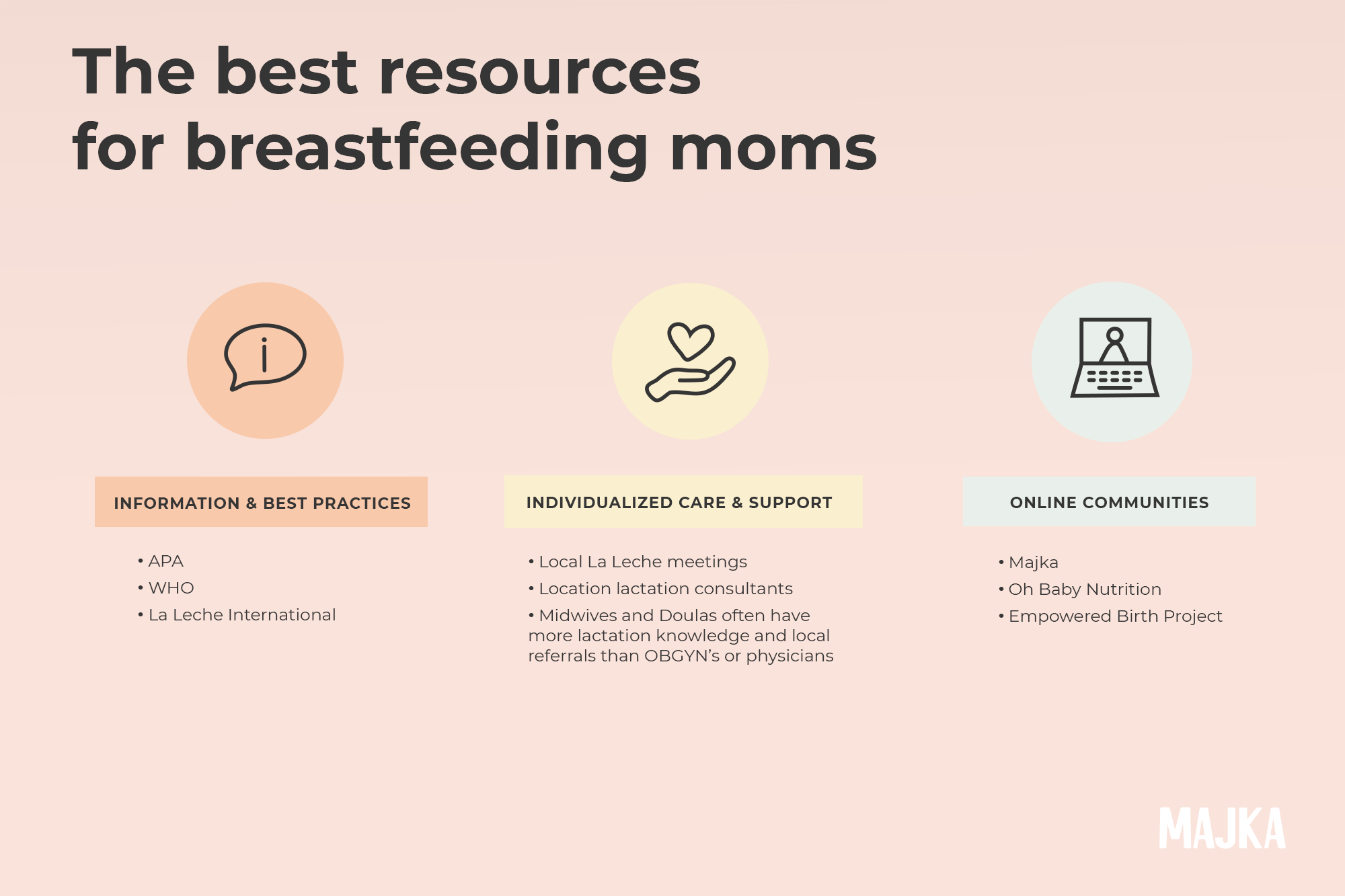
The Best Resources for Breastfeeding Moms
There are more and more community and grassroots organizations that are supporting breastfeeding moms. While hospitals have improved practices, there are groups like La Leche League international as well as local lactation consultants that are able to give a mother the one on one advice and attention she needs. Mothering and learning to breastfeed are huge tasks! The best support a mother can get is allowing her to focus on bonding with and taking care of her baby.
For Information and best practices
For Individualized Care and Support
- Local La Leche meetings
- Local lactation consultants
- Midwives and Doulas often have more lactation knowledge and local referrals than OBGYN’s or Physicians
Online Communities
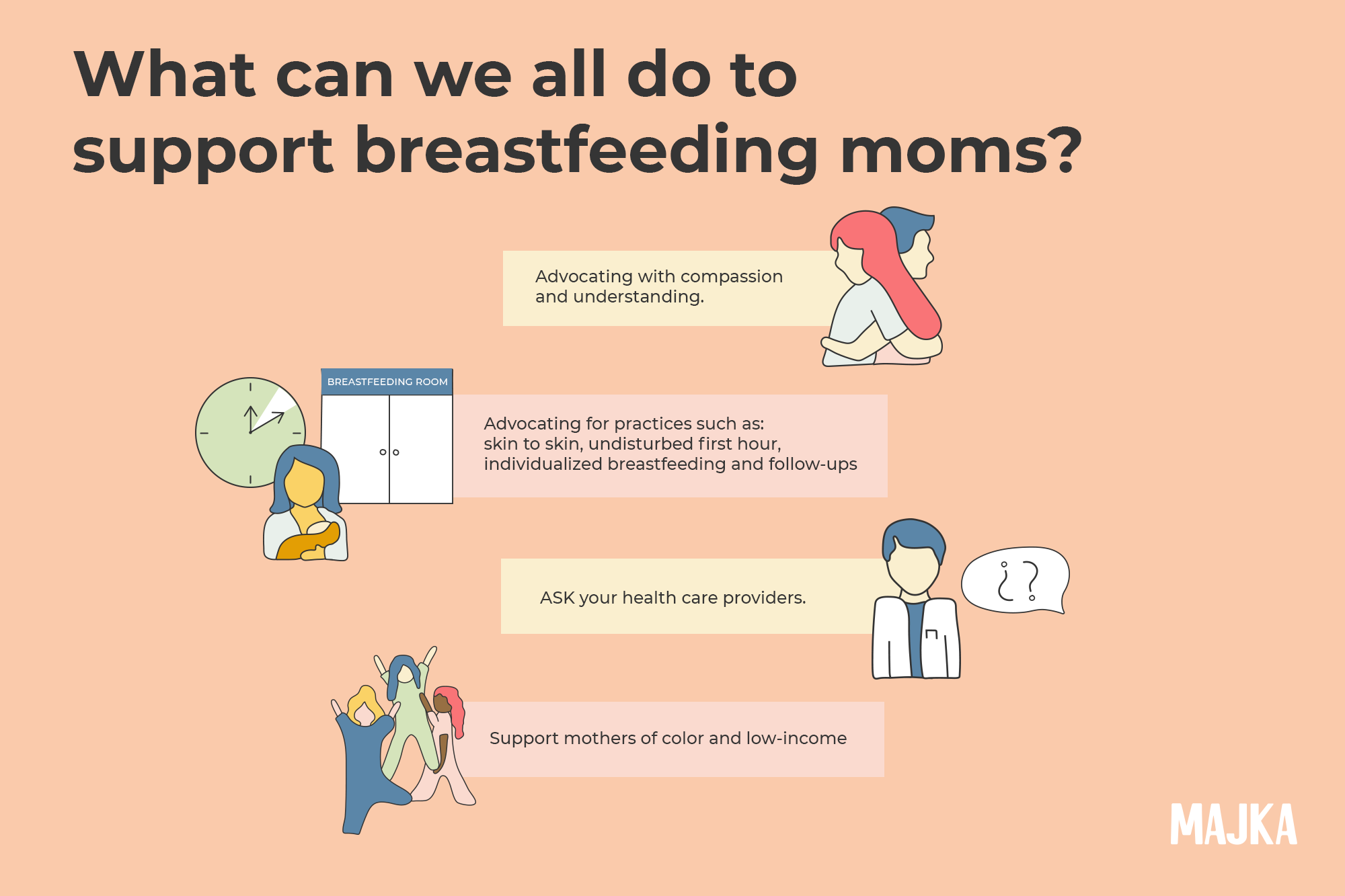
What Can We All Do to Support Breastfeeding Moms?
Simply being an advocate for breastfeeding with compassion and understanding is a huge win as we shift the cultural norms back to breastfeeding. Advocating for practices such as immediate skin to skin, an undisturbed first hour, and individualized breastfeeding support and follow-ups are key. Many of the hospital practices are there because of tradition and not because of necessity. ASK your health care providers whenever possible how they are supporting breastfeeding success.
For those in a place of privilege, advocate practices that support mothers of color and low-income families. Community platforms are often the best place to ask how we can support and what actions make the biggest impact.
Mothers do what is best for their children. As mothers, it is our responsibility to shift and adapt as we learn new information and be an advocate for the best nutrition possible for our babies. Thriving mothers and thriving babies will always be the foundation of a healthy world.
End Notes
- AAP. Breastfeeding and the Use of Human Milk.
- Centre for Disease Control & Prevention. Breastfeeding Facts.
- Weaver JM, Schofield TJ, Papp LM. Breastfeeding duration predicts greater maternal sensitivity over the next decade. Dev Psychol. 2018;54(2):220‐227. doi:10.1037/dev0000425
- World Health Organization. Breastfeeding.
If you want to learn more about motherhood and breastfeeding, check out these free resources and posts to help you feel confident and prepared as a new mom!





